Elegant, Competitive, Global
Roger Federer
on His Two Decades on Tour
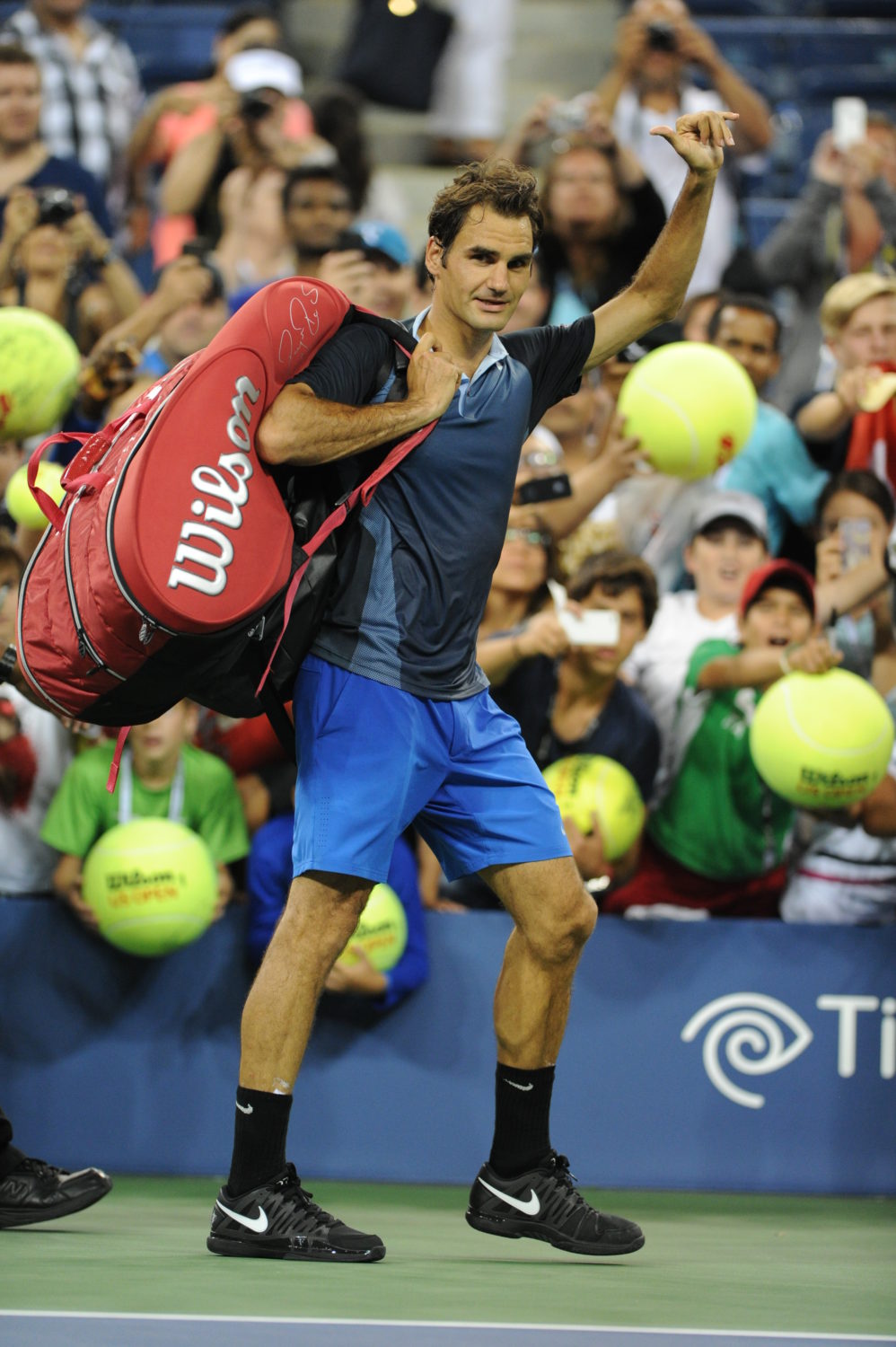
That was the challenge Courts Magazine and Wilson set for Louis Castellani. When the 45-year old, father of two and life-long tennis fan is not being a lawyer in London, he’s on a tennis court or messing around with his hobby Instagram account @vintage.tennis. His tennis idols are Borg, Lendl, Sampras and Federer.
“I thought to myself, if the greatest player ever, Roger Federer, sat next to me one day on my 30-minute train journey into work, what would we talk about? What do I want to know from him? And in one word it came down to longevity, which was also relevant to the heritage of the Wilson brand. I wanted to know things about how this guy with four kids who’s a couple of years away from being forty is still able to compete at the very highest level in professional tennis.”
August 2019. Roger was competing in Cincinnati and had beaten Juan Ignacio Londero 6-3 6-4 the day before. Louis was on vacation sipping a Campari when suddenly his phone rang from a mysterious Swiss mobile phone number: “Hi, it’s Roger…”
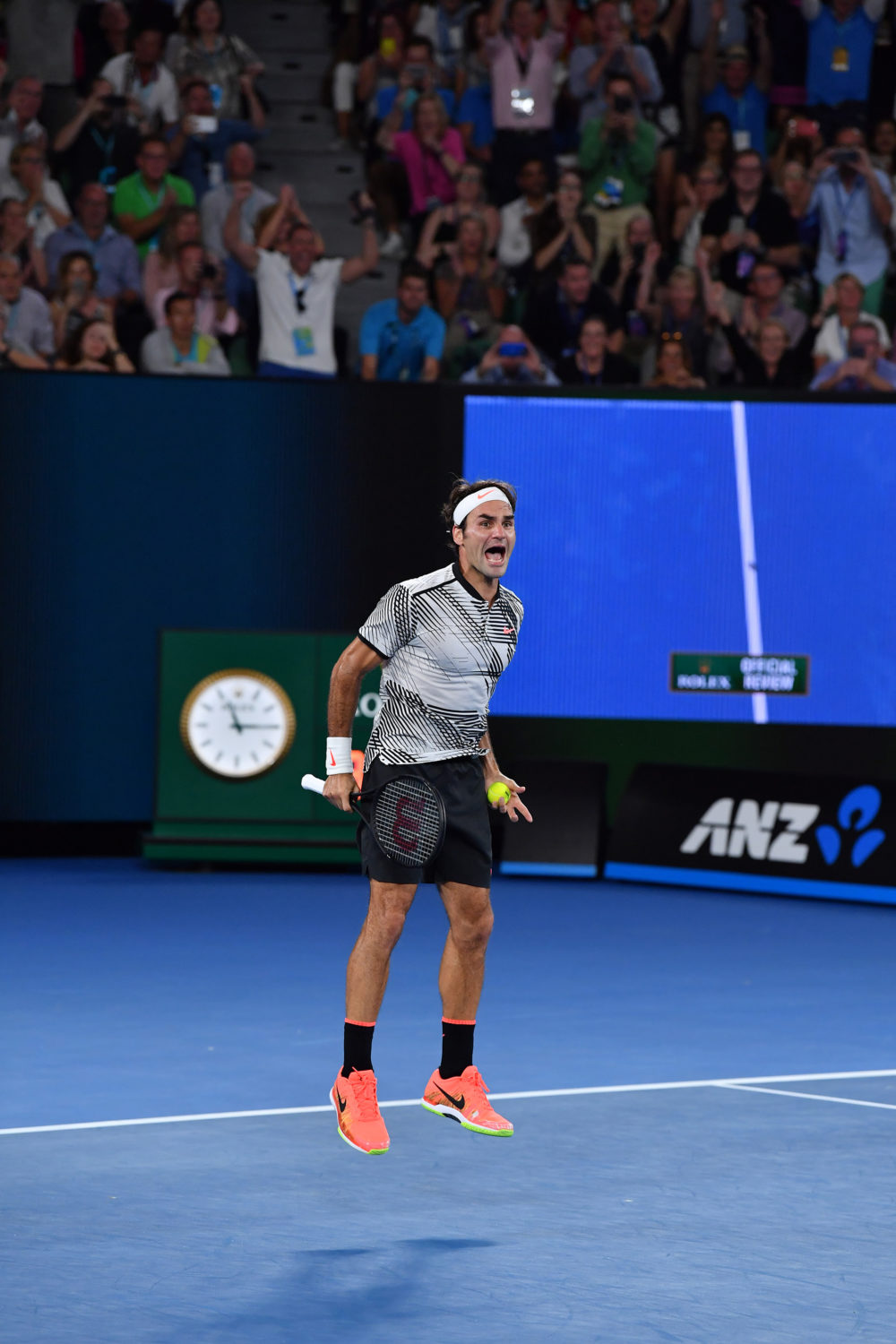
LC:
Just to introduce myself and this interview very quickly before we get going. My name’s Louis Castellani and when I’m not being a lawyer in London I’m doing something around tennis and on this occasion contributing to Courts Magazine which is the magazine this interview is for. It’s a quarterly, thoughtful, francophone, magazine. It’s in its 6th edition. Some of its commercial partners so far have been Rolex and Wilson. And for the first time, we are doing something in English and in French with Wilson. So this interview is central to that because one of the major themes for the Wilson edition in English is going to be longevity of the Wilson brand, its relationships with players and the careers of the players themselves, so this interview with you Roger is absolutely central to those themes.
RF:
Right ok.
LC:
So we put together some questions all around longevity, so if that’s okay we’ll get going.
RF:
Absolutely, I’m ready, let’s do it.
LC:
Ok! So, you’ve been on tour now for a couple of decades and you’ve maintained the highest of levels ever in that period. At this stage of your career, what is now the hardest part of life on tour? For example, is it the daily physical regimes and disciplines to keep yourself prepared, is it being single-minded and focused on controlling distractions? Where’s the difficulty at this stage of your career?
RF:
Well I mean, obviously I think organizing the entire family to get on the road takes major organization and just planning skills and also patience and all that stuff, you know, because it’s just a lot of work. But you know, as long as it all is worth it and the kids are happy on the road and we are having a good time, it’s all good you know. As a player, I think it’s just how you keep the fire burning because I’ve been to a certain tournament-let’s say Cincinnati-20 straight years, I’ve been to Wimbledon 20 times. You still want to make it as special almost to some extent like it would be your first, second, third time you know, or like when you first tried to defend that title so you want to have that fire burning to win every single point, win every single game, win every single match and beyond. So I think just being able to keep that going I need a really strong team around myself you know, that also helps me to squeeze that extra one percent, ten per cent, whatever it may be out of me, and remind me to bring the energy for the next match. Just because it’s a second round, for instance, doesn’t mean that we’re not going to be motivated and into it, so I just think these little things, that maybe are completely natural in the beginning, you maybe just have to be aware of as you get older on the tour. In terms of physicality, I think just listening to the body, the signs and managing a good schedule.
LC:
So it’s about doing everything to avoid hitting that cruise control button, it’s about staying alive to everything around you?
RF:
Yeah, basically.
LC:
The physicality of playing on tour for a long period of time-like you said, your 20 Wimbledons straight-has that required you to adapt what you do off the court with training and fitness? I mean, how have the things you focus on with your team changed as you’ve developed as a player?
RF:
Well, I think in the beginning, you know, when you’re younger you have to put in the hours, you have to be able to stay focused, prove to yourself that you can stay with your opponents, focus on the ball for 2, 3, 4, 5 hours you’re doing a day, and also physically you can endure the stress and everything. Also, you know it’s one thing doing it in practice but it’s also another thing being able to prove it in the matches when the stress level gets greater. You could cramp because of stress, playing with fatigue like jet lag, changing surfaces from one day to next, to changing surfaces to play another match. I think in the beginning it’s all a learning experience but you have to learn quick. And then later, you know it all so you don’t have to work on it that much anymore, so it becomes maybe more. I believe in quality over quantity if you like.

LC:
You mentioned jet lag there. We, the viewing public, I think, underestimate-do we, do you think–the effect that has on those early rounds when players arrive just a few days beforehand. Do you have to really think about that as part of the schedule?
RF:
100 percent, 100 percent. That’s why you sometimes as a professional can say like “ok I’m going to sacrifice a few more days at home to leave early to the tournament to get over the jet lag”. The thing is, you just don’t know if that’s really going to make a difference in the draw, and sometimes being home for a bit longer makes you maybe a bit more happy, so you always have to weigh it-is it worth it, you know, but that’s why maybe you would try to have a schedule that doesn’t go make you go from South America to Asia to America to Europe to Africa to America you know, so you try to have it in swings rather. But I do believe when you’re playing with jet lag you have a bigger chance and a bigger risk of injuring yourself. The body might be sleeping and you’re awake or vice versa. Like yesterday, I mean I arrived Friday so I feel like I’ve arrived plenty early enough, but yesterday I played at night at 7:00 PM, and with a 6-hour time change so that’s like in the middle of the night, and I’m walking out on court-I was happy I got through, you know, just because you just don’t know. Maybe you’re feeling all of a sudden tired when the third set rolls around. Now, winning yesterday gives me an extra couple of days to get over to jet lag again so I do believe how you manage jetlag and how you manage your flight and pre-flight routines all makes a difference in your health throughout your career.
LC:
Yeah, it’s all the hidden stuff. I mean another big challenge talking about the body is playing 5 sets.
RF:
Yup
LC:
We often hear tennis pundits talk about the challenges of playing 5 sets because it doesn’t happen at that many tournaments anymore and particularly the recovery for the next match when you’ve won. You often find your way through a drawer, but you’ve played and won some big 5 set matches. What’s the toughest bit of recovering for the next match a day or two later when you’ve won in 5? Is it as simple as the shoulder and arm, it’s sore, or is it general fitness, is it the emotional side, whether it has been hot?
RF:
I really think you can’t put a finger on it and say, like, it’s always let’s say the arm or the shoulder or the back or whatever it may be. I think always everybody has a sort of a problem, you know, that pops up faster-for some it’s the back, for some it’s the foot, for some it’s the shoulder like you said, but I think it’s just that the overall energy comes down a little bit, that explosiveness maybe, you know, that peak of point for point mentality and that sharpness you have maybe has just been shaven off a little bit when you’ve played a 5-setter, so you really have to give sort of extra effort to recreate that energy, it doesn’t come natural anymore maybe. That’s maybe one thing I see that maybe younger guys struggle with the most and maybe even when you get older too, but obviously the problem is if you’re playing 5 sets and you’re carrying somewhat of an injury, that injury probably will only increase as the tournament goes on, and that’s why people do say “you can’t win a slam in the first week, but you could definitely lose it.”
LC:
I see that. You touched on injury there. Players, I suspect just about every player, walk on court with some kind of constant but managed injury or recurring injury they’re carrying that no-one really knows about outside the team or the locker room.
RF:
Right
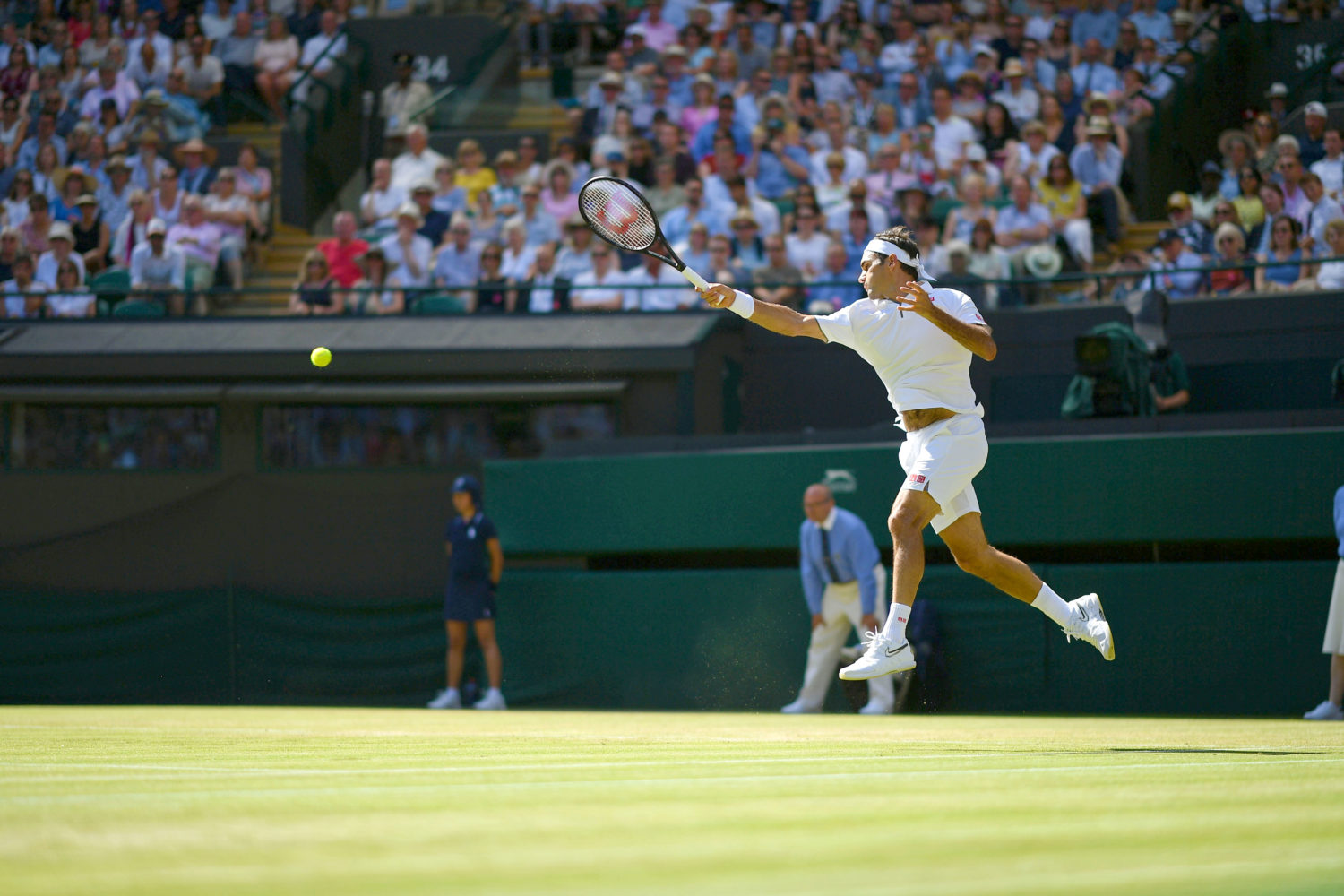
LC:
I mean every player is different, but generally how do players, how do you, play through an injury and still manage to be competitive on tour? To people who aren’t on tour it’s a difficult thing to get around because you put the racket down if you’re a club player whereas you guys are carrying it and you play through it, so how do you play through?
RF:
So I think it’s important to listen to your body and understand the signs of the body, and as long as you know that the injury cannot get worse or much worse it’s worth playing, I believe. If you know that you could literally snap a tendon or you could break something by playing further, if that’s going to really damage the future of your career or take you out of the game for a long period of time, you’ve got to really weigh it up-is it worth it, you know. But then, you could always just not walk on court the day of the match just because it’s like “I just cannot take this chance right now,” but more often than not, I always believe you can navigate through the pain or the injury and I always tell myself maybe if I’m hurt or not feeling well, I tell myself well maybe my opponent is also carrying something-who knows-or maybe it’s gonna start raining, or you know, you never know but you might get lucky, and you win a match and the next thing is the next day you feel better. But I think most importantly is that you understand how severe your pain or your injury is.
LC:
It requires a lot of mental toughness to cope and manage the pain.
RF:
Of course, that goes without saying, that sometimes it just is really uncomfortable playing sick or injured but I feel like this is what we do and as long as you are not taking a huge massive health risk you know, it’s ok, but yeah you don’t need to shout about it I think we’re all very tough on the tour.
LC:
Sure. The tennis season is a long one and I won’t get into that, but at the end of it some players head for the beach, others for some intensive training blocks. You’ve previously streamed from Dubai some of your winter training although it didn’t look much like winter I have to say! Do you consider the November-December period before Australia as your off-season for recovery or your pre-season to prepare, or a bit of both?
RF:
Yeah, I mean obviously it sort of resets January 1st in a way. I mean it used to be the classic off-season where you’re taking a break and then you’re really having the pre-season right after, and you train really hard and that’s what you do. But since I schedule maybe a bit differently now and I have a family as well, I have several of these blocks in my year when I do have time for a break and time for preparation, and usually I have 2 of them: one at the end of the year and one mid-year. In the previous years, I had one during the clay-court season, this year now I didn’t because I’m still profiting I think from working hard in those off-seasons. I think they’re very crucial for a player and how they can prepare because when you are able to take 6 to 8 weeks off, take a proper break of maybe of 10 days to 2 weeks, and then train really hard physically and eventually also add tennis to that, you can really improve your potential. The problem is that if you’re only playing tournaments all the time, and not taking enough time to practice, you actually will not really improve. You become a better match player, you become match tough and all that, but actually your shots or your game are not really evolving and that’s why I’m a big believer in training blocks. Because just imagine if you now went out to the court and just worked six months on your serve and volley game-you would be such a better player, you know, but nobody dares to do it because you have ranking points, your ranking might drop, you want to play tournaments, it might be a financial thing too-who knows. But I think it’s really important to recognize that, to become the best player you can become, it’s crucial that you utilize those training blocks the right way.
LC:
Yeah, although some players are using an injury and really capitalizing on it just to do that kind of game improvement.
RF:
Yeah, and very often you see when somebody does return from injury, how hungry, fresh and rejuvenated they are, you know, you see it very often so it shows taking breaks sometimes is a good thing.
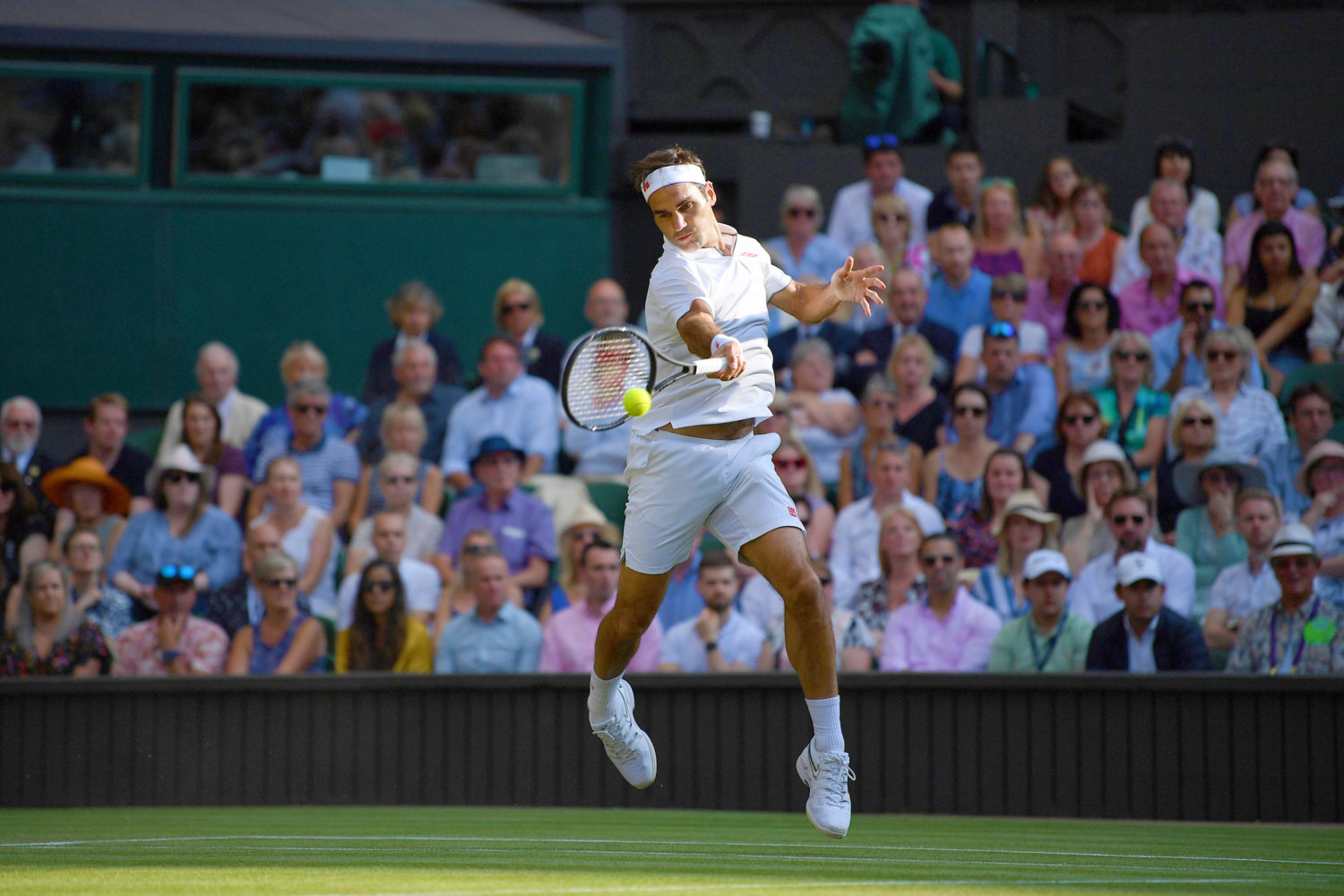
LC:
Talking a little bit now about equipment. You’ve played through an era of tennis, when you look back, that had quite significant racket and string innovations in it. You adopted them with hybrid stringing and a bigger head size on your Pro Staff. This is a difficult question, I think, unless you are very close to it, as you are, but where do you see the next trend or big leap in tennis technology? What are you seeing? Are people taking weight out, maybe lowering tensions? Where’s the next big thing?
RF:
Yeah, I mean I think the big switch was definitely, obviously, from the wooden rackets to the rackets we have today, and then racket head size and how that’s grown, and then string technology how that really gave us an opportunity to be able to hit through the ball in a completely different way than we could do it before in terms of angle, power, consistency and all that stuff. So I would think, if you ask me, the biggest jump might be another type of string that is just going to give us even more velocity, more spin, more power but with control, you know, I see being another leap there. I don’t know how much more can be done in the racket, but we see more powerful rackets more than ever, and the guys are getting bigger and stronger and taller and all that stuff, so I think it could be a bit of both, a combination. But I do think that maybe we have most potential with the strings, because not long ago when I came on tour I also still played with all gut strings so maybe there is a certain sort of way to create like some other incredible type of string.
LC:
I mean, your RF97, I’ve hit with it, it’s an axe, it’s not for the faint-hearted! What is it about the weight, balance, swing weight and all those things, that makes it right for you? It’s not dissimilar to the original Pro Staff 85 in terms of some of the specs so there’s a kind of pattern to it.
RF:
Yeah, well, I mean I think you grow up with a certain feel you like, grip size, swing weight, the weight in general. I switched to that Pro Staff 85-the racket that Pete and also Stefan Edberg used to play-back when I was 14 already. I mean, that was like you said an axe or hammer in my hand at the time because I was still half the size I am today basically, and I was playing with it, you know. Nowadays, I know that kids grow up differently with different types of softer balls, the smaller rackets maybe for a longer period of time, but eventually you gotta switch to the more solid racket. Every player has different preferences and then your game also shapes towards the racket you play with, and vice versa too. I think it’s actually a very versatile racket, you know. I feel like everybody can play with it, that’s why I’m happy Wilson created the different types of models with different weights because I understand that not everybody has the power to play with a lighter racket. But the advantage you get with the heavier racket is that you have less vibration, you have easier power and having easier power also helps you just on a daily basis; it’s easier to play better consistently. It’s just nicer to play, that’s my biggest switch with the 97-which also I realized when I went from the 85 to 90 and then from the 90 to 97-it’s just how much easier it is on a daily basis to play with this the RF97 I’m playing with now. I remember, with the 85, I used to play and just think to myself: every ball I have to be in perfect position not to shank it. Now that’s obviously very different with the 97.
LC:
That 85 had a tiny sweet spot
RF:
Yeah
LC:
Wilson put some footage online of you having a hit for fun and I think you were doing it–with their new Clash racket. A much lighter racket.
RF:
Oh yeah, exactly
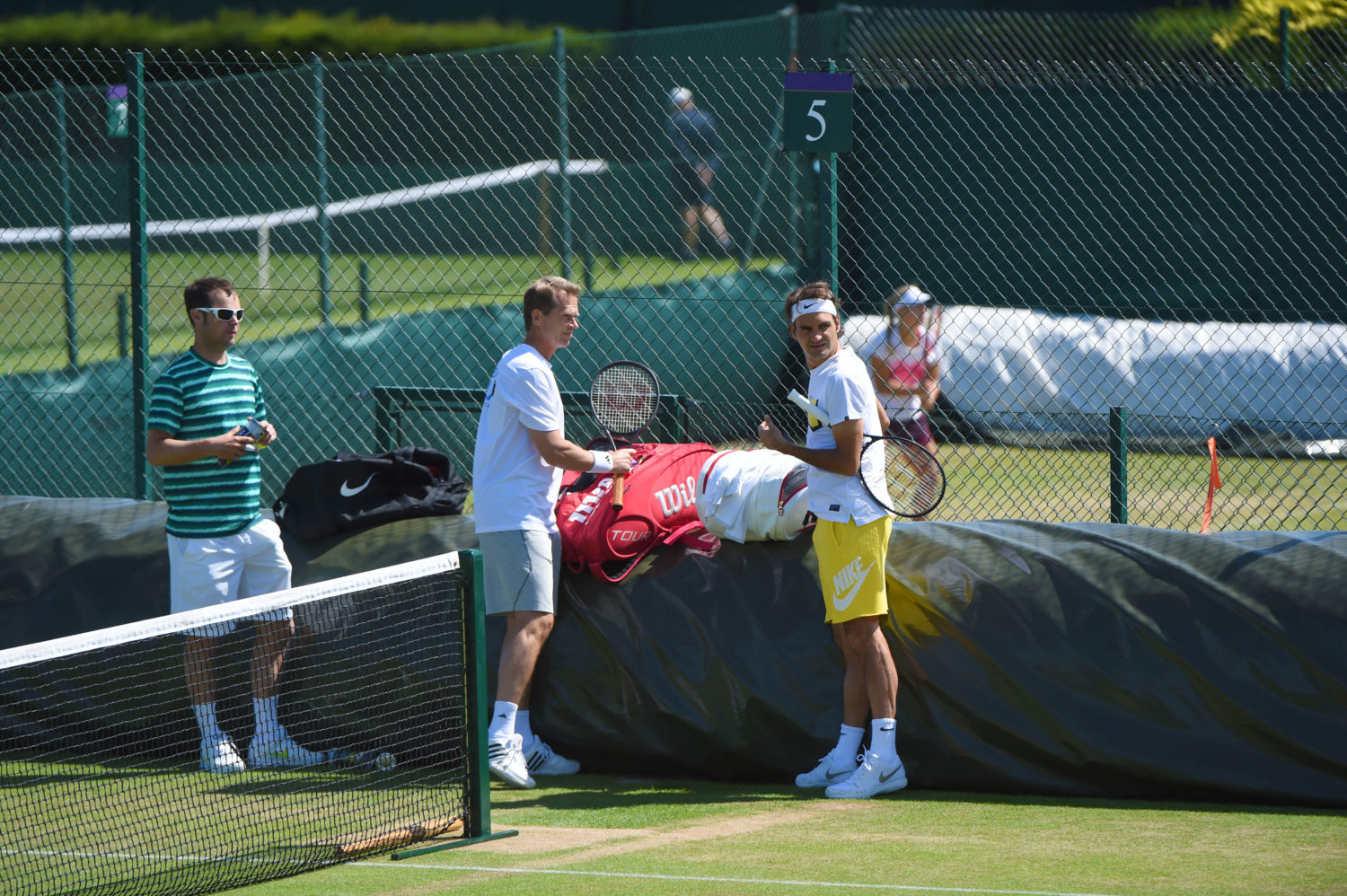
LC:
I mean that’s just so easy to hit with going from your RF97. Some days do you just think, man, it would be so much easier if I could just hit that easier racket, maybe with the kids?
RF:
Absolutely. I played with that Clash and I was like “oh look how it just jumped out of the strings and it’s just so much easier.” I mean I could play I’m sure with it on tour as well if I did the proper weight and balance for me, you know. Being able to return a 142mph rocket from somebody serving big, you need something in your hand that can absorb that. But it’s true, I think nowadays as the junior growing up you have a great choice of Wilson rackets that really help you with the game. I do believe still it cannot be all about the racket, it also has to be about how you evolve your game, but that Clash is a great example of how to make it easier for players getting on a tennis court because it’s just that much easier to hit with.
LC:
The next 3 questions are little bit about tennis in a sort of wider context. The first one is this. Has tennis taught you any lessons over the years that you think are relevant to real life off court, you know, real life, how you adapt what you learn on court?
RF:
Oh yeah, yes of course. I think anticipation. You know on a tennis court we anticipate every single move we do, basically–“is he going to play there or there?” I think in life you do sometimes the same, not every step you take, but you know in life we also anticipate a lot, we try to plan a lot and that as tennis players we have to do that, take a decision, micro decisions, on a tennis court, you know, “what’s going to happen next, where shall I serve, what am I going to do.” But then also just in general too from a business perspective I have to take so many decisions you know–who I want to work with, which tournaments to play, how are we going to do this, yes or no to sponsorship or to press requests whatever it may be, so I learned a lot there. And then all the stuff when it comes to being able to battle through the sort of perseverance that we were talking about before, you know, fighting through injury, overcoming tough moments coming back from defeat, how do I handle it now coming back from my Wimbledon loss, am I just going to say, like, “aah that was too bad but I don’t care,” or am I going to say, like, “well that kind of was terrible, I want to, I need to go back on the practice court and train really hard,” or “you know what, I just need a break”-how do you get back from a moment like this and how do you stay motivated after you’ve won it all-I’ve done that. I see a million things that I’ve learned from tennis and I’m super grateful.
LC:
The culture of tennis, there are some things in it that remain constant but it is also forever changing as generations go through it. In 3 words how would you describe the tennis culture today?
RF:
Hmm. So I think tennis has always been an elegant sport, so I’d say elegant, I think people see it that way too, there is the sort of the ballerina aspect as well that we have on the tennis court. I think it’s an arena sport you know in a way, I think the stadium’s big but not too big so I think it’s intimate and really elegant. It may be one of the most global sports. We go on the world tour from January to November, so I always compare it to us being a musician going on a world tour. Musicians don’t do it every single year but we have to, and we do it every single year so I think it’s super global. And then I just think it’s competitive. It’s super competitive, there’s a lot of tennis players out there. With that ranking system you have to defend what you did the year before, you know, you’re only as good as your next match and it makes it very hard, you know, in some ways, to be at the top and I think the competition is huge, so I’d say it’s elegant, global and competitive.
LC:
I had two of those. I have heritage in there which I think is the same thing as elegant.
RF:
Yeah I think heritage is like elegant, I’d go in that direction for sure. What’s the other one?
LC:
Well I had global, gladiatorial and heritage.
RF:
Oh yeah, there we go. We’re very similar, good. I’m happy we agree!
LC:
You talked about the business world before. Relationships come and go and you rarely, and very rarely in tennis, see an athlete stay with the same set of partners for their full career, but you’ve done that with Wilson.
RF:
Yup.

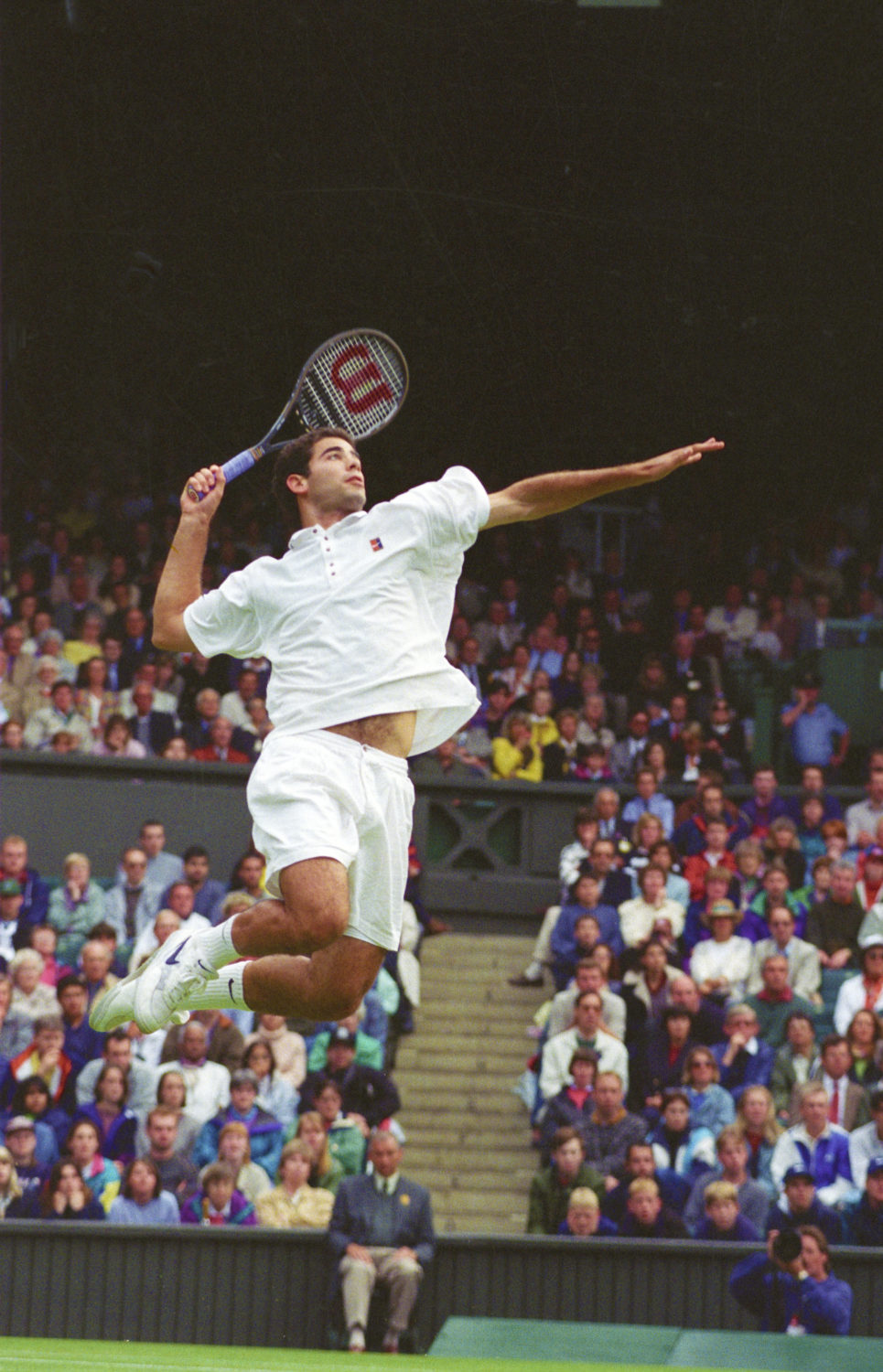
LC:
We touched on it a little bit earlier when you were talking about moving to the Pro Staff when you were 14, but what has made you want to be with, and stay, with Wilson throughout your pro career, and even before?
RF:
Well I mean I’d say that Wilson is very strong on grass roots, you know. As a junior, you’re not really aware of it, all I remember is that a lot of my friends all played Wilson and then you know my heroes played Wilson, as in Sampras and Edberg, and that’s the racket I wanted to play with, you know, a Wilson racket. And then when I got to know them, even at a junior level, they were all very supportive and helpful when it came to a grip here or a string there or whatever. I just always felt like the local people at Wilson were really well-equipped already to help a young player to feel special, you know, I think that was nice for me especially with my parents who come from very normal backgrounds. We were happy with any support we could get, like getting a free racket or something that was very helpful already at a young age. I think in some ways you are also forever grateful you know, for that, the initial help that we received. And then I think just getting to know top management and the people at Wilson. I feel it’s a family and, I don’t know, I always had a great time with them, they couldn’t have been nicer to me. And I think the racket you know is the extension of your arm so you want to be really comfortable with the racket. And talking to them about new technology and what else is going on. And I think we’ve always had a wonderful relationship with one another. We never had any issues ever and you know I don’t see myself ever changing, I remember where I come from, where they’ve been with me all along the way. This is more than just a business agreement in my eyes.
LC:
I mean you’re in that kind of dream scenario which is having your first racket which is the 85, then your 90, then your own custom 97, all on your garage wall one day.
RF:
Right, yeah, well I even have rackets from the before the 85, I had the Thunderbird or whatever it was called and other ones that I don’t even remember the names. Yeah, I’ve played Wilson since I was basically 8 years old, since I started.
LC:
You mentioned the word “stadium” when we were talking about the three words that describe the culture of tennis. Playing on Centre Court in SW19 on the one hand, all quiet and hushed, and then heading where you’re going to be heading, to Arthur Ashe in New York-those are very, very different tennis playing environments.
RF:
Very.
LC:
I’m not going to ask you to choose one because that’s not fair, but I think most people would find the Arthur Ashe incredibly difficult to play on, people who aren’t pro.
RF:
Right.
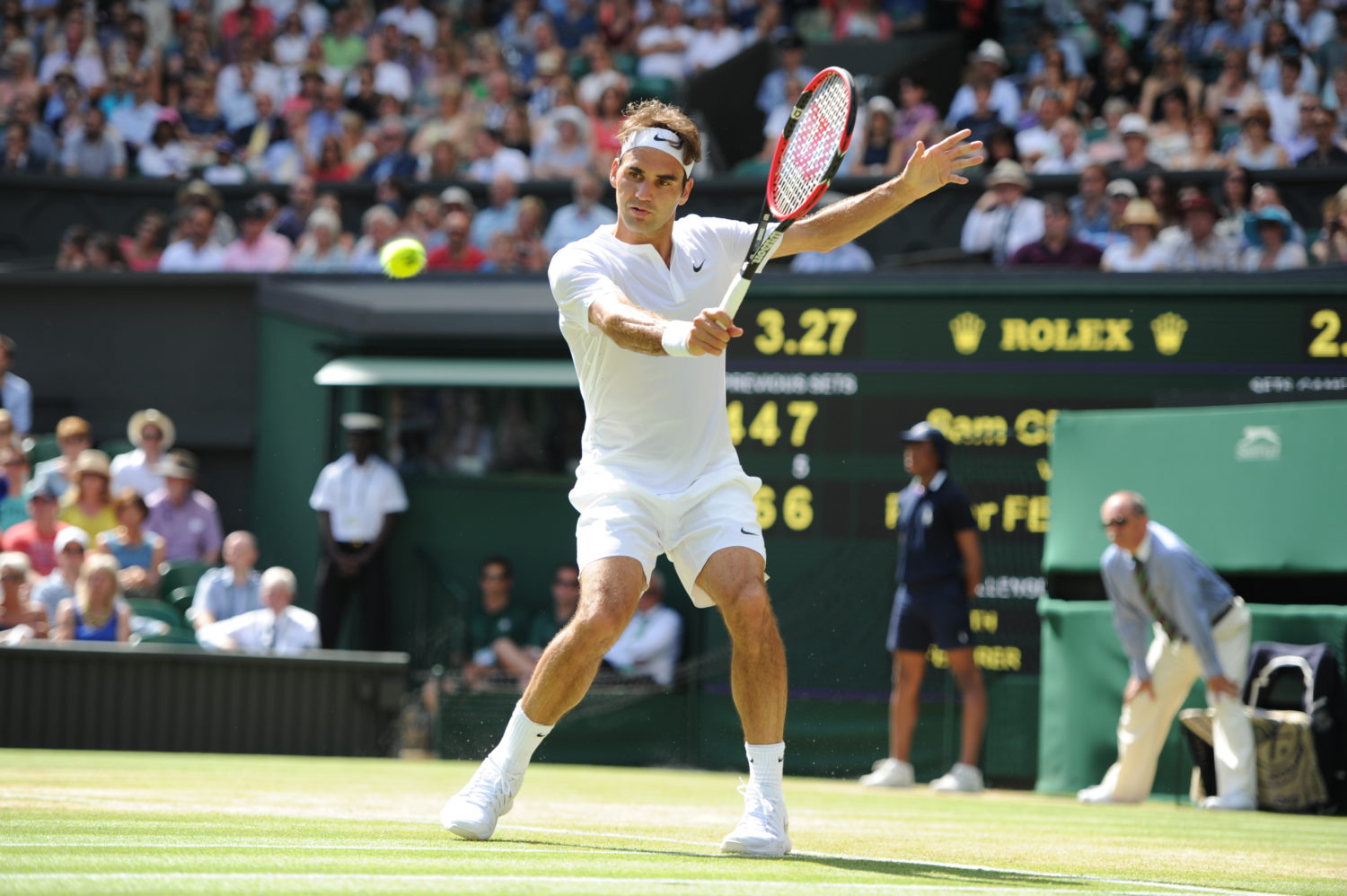
LC:
How do you keep focused when you’ve got that going on around you, the noise?
RF:
Well I think the good thing is that a lot of the practice courts sometimes are very busy and loud. Like here now [in Cincinnati] I was practicing next a ventilator the last few days and then there are trucks driving in and out, there are the fans. The practice courts usually are a more sort of savage environment, you know. So usually when you go on a match court it’s much easier to focus, right? So I know the US Open might be tough, because it’s loud, there’s the pressure of the stadium, you do hear the subway going by or a train on the track, you feel like you smell the grill of the hot dogs and all that stuff, and it’s loud at the change of ends, they play the music and people are dancing, and there almost is this culture as well that maybe the fans are talking during the point to some extent, because that’s what fans are allowed to do in basketball, and baseball and NFL and all that stuff. But it’s only in tennis that it’s really just a hushed, super quiet environment and then you’re allowed to be loud at the US Open, and I think that’s the beauty of our sport. I hope you never lose it and that’s what’s so nice about Wimbledon, the difference. But I think, because of the practice court anywhere never really feels like a match court, it’s actually quite easy to go out on the US Open courts. They have incredibly beautiful dimensions, there’s no glare in the Arthur Ashe stadium you know because of the size of the stadium itself so the sun cannot creep in from the side you know, because it’s blocked by the stadium. I don’t know, I just think it’s a great place to play and what I like about the US Open, what I like about the pressure of the US Open and Arthur Ashe, is that basically you feel the people show up there, it’s like at the movie theatre-they eat their popcorn, and then they are waiting for something to happen and then once you start making good shots, good points and you show you are engaged, this is when they are like–“oh right this is when the movie starts, this is the entertainment factor we’ve been waiting for and looking for,” and that’s when they engage fully and they’re one of the most incredible crowds in the world that I love to play in front of. I love to play at the Open, I mean I love playing at Wimbledon too, and if you ask me as a tennis guy probably I’d pick Wimbledon just because, you know, but I’m happy it’s not every week Wimbledon, like I’m happy it’s not every week Arthur Ashe but the combination is crazy good and I love both equally.
LC:
I mean Arthur Ashe is like a modern-day Coliseum in Rome, it really is that kind of atmosphere, the crowd get so into it.
RF:
Yeah.
LC:
Last couple of questions Roger, short fun ones. So, looking back, what advice would you give to your 20 year-old self? So, you would have just started out on tour, maybe been on there a year or two, what advice would you give yourself looking back then?
RF:
Ooh, well it’s funny you know. In a way I’d say like “hey don’t worry. You have time Roger,” and at the same time like “it’s going to go by fast.” It’s a bit of both because you know a lot of the time when you’re young, you’re like it’s got to happen right now or tomorrow, we don’t have time, you gotta do it. At the same time, you realize that “Hey, we have time, take your time, practice, you know, don’t stress out about everything.” So I think it’s important to enjoy it, you know, not stress too much about every little detail to begin with, try your best, learn quick-I think learning quick and not making the same mistakes a million times. And then trust your coach and trust the training. But then really get stuck into the details because I do believe at the very top on the professional tour, it’s the details that make the difference.
LC:
Last question. What advice do you think your 50-year old self would give you now?
RF:
He’d tell me play for a few more years!
LC:
I thought you might say that!
RF:
Really?! I don’t know, I’d be like “Come on Roger, try to play as long as possible and enjoy yourself.” I hope that’s what he would say!
LC:
I think my 50-year old self would tell me not to shout at my kids so much!
RF:
Yeah ok we can go that route too! We’re in the same place then!
LC:
Roger, thank you ever so much for making the time today.
RF:
Of course, it’s been a pleasure.
RF:
Take care, no problem, speak to you soon. Bye bye.